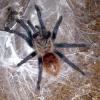So far only two have been produced but that's still pretty good for a colony of about 100. Not sure what to do with them, should I pin them and add them to my collection?
Second photo is size compaarison to a major worker. This colony seems to put out a small and a large worker so I'm guessing they're polymorphous. 

I find it interesting how the males are all black but the queen looks nearly identical to the workers in shape and color but with a slightly larger thorax.
Edited by klawfran3, July 15 2017 - 7:12 AM.















